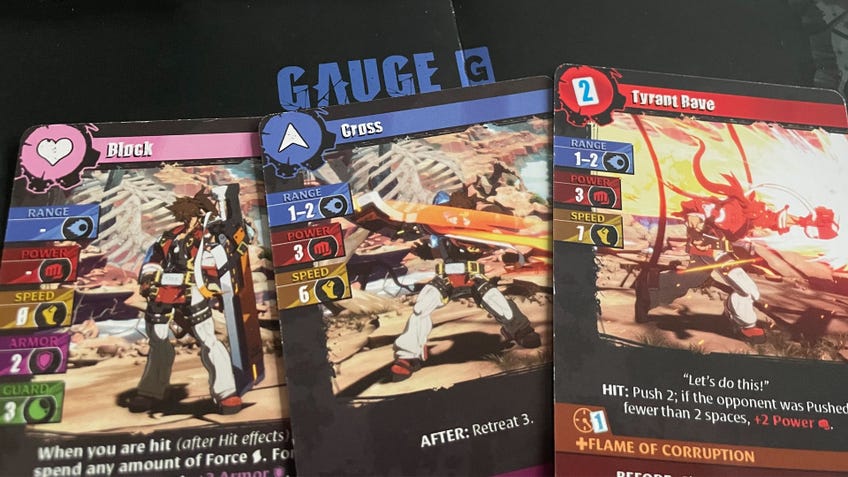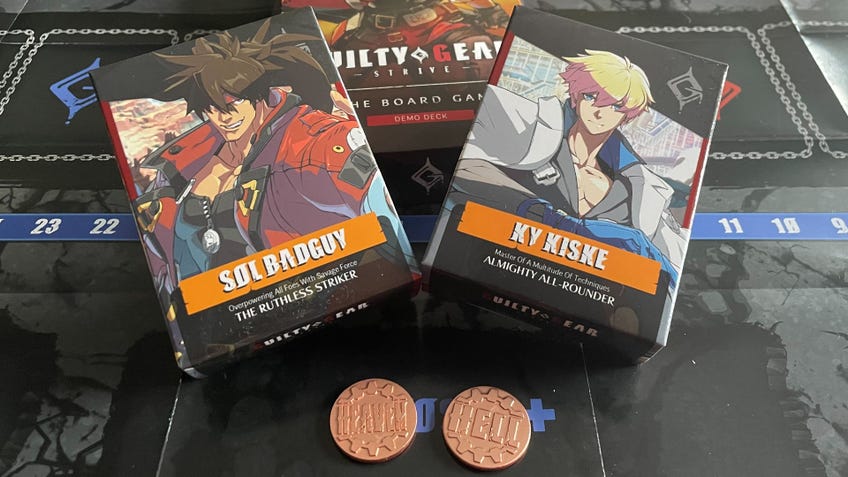Guilty Gear Strive: The Board Game hits as fast and hard as the video game fighter
I’m Sol’d.
Of all the video game genres to adapt into a board game, fighting games seem about the most difficult. On screen, classic fighters such as Street Fighter and Mortal Kombat are built around split-second button inputs, memorising combo strings and lightning-fast decisions to strike, dodge or block. Translating that to decks of cards, regimented player turns and asking the players to handle the calculations normally resolved in microseconds by computer code seems like a recipe for disappointment, if not outright disaster.
But fighting games can be successfully turned into board games that manage to feel just as fluid and hard-hitting as their on-screen cousins. Arguably the most successful at reaching those heights is the Exceed Fighting System series, which triumphantly returns this summer with a board game adaptation of anime-styled video game fighter Guilty Gear Strive.
Even for fighting games, the Guilty Gear series can be notably demanding, with faster moment-to-moment action and greater character manoeuvrability than the likes of the slower Street Fighter and Mortal Kombat-a-likes. With Strive, developer Arc System Works worked to make the long-running franchise more approachable for newcomers, maintaining its fast pace and fluidity but lowering the complexity of pulling off multi-attack combos, cancelling out of moves and closing the distance to your opponent with a dash.
Based on my time with Guilty Gear Strive: The Board Game so far, having been provided with demo decks featuring Sol Badguy and Ky Kiske by publisher Level 99 Games ahead of its upcoming Kickstarter campaign, its tabletop adaptation so far manages to strike a similar balance between welcoming in new players with a simple set of basics while keeping the skill ceiling high for those who want to take things to a more competitive level.
It’s a clever, accomplished system that truly feels like a video game fighter at its core.
The two-player board game sticks close to the familiar one-on-one fighting format of the video game, with players looking to whittle their opponent’s 30 health down to zero by landing attacks. As two of Strive’s characters - the full game will include 20 characters - the players each have a unique deck of cards that include basic attacks and moves alongside their character’s individual specialities and more powerful abilities. Setup is beautifully brief: you pick a character, lay out the central board and place your characters on their starting sports (the demo pack uses the characters’ cards on a paper sheet; the game’s deluxe edition will include acrylic standees and a neoprene mat), shuffle your character’s deck, draw a hand of cards, and you’re ready to fight.
Each player only takes a single action on their turn, helping the game to get as close to the rapid speed of a fighting video game as any board game could hope to. Not every turn involves exchanging blows, as the fighters can shift back and forth across the central track - neatly capturing the 2D plane of the video games and opening up the need to plan around the varying range of different attacks. Players can move their characters around the board by spending cards from their hand or gauge (more on that in a second), closing in or backing away - or even leaping over their opponent - to set up their next move. You can also play cards for the boost at the bottom of the card, buffing up your speed, power and other effects before your next strike.

When a window opens up for an attack, players strike by laying a card from their hand facedown. Your opponent also has the chance to counterattack, evade or block by placing their own card facedown. (In a playful nod to the video games’ sometimes chaotic flurries, either player can also choose to take a ‘wild swing’ by drawing randomly from the top of their deck instead of their hand.)
The slick, constant motion helps the board game to feel as nimble and energetic as its video game counterparts.
Attacks are resolved based on speed, power and guard - with faster attacks having the chance to stun an opponent if your power exceeds their guard, leaving them unable to respond - with additional values such as armour helping to mitigate incoming damage. While the low number of stats help to make understanding your character’s distinct moveset easier, and avoid spending minutes having to think through your next play, there remains huge potential for cutting through slow attacks with fast jabs, overwhelming your opponent by breaking their guard, and gritting your teeth through damaging blows by blocking rather than always going on the aggressive. It’s a clever, accomplished system that truly feels like a video game fighter at its core, and allows for plenty of room to dig into the way that different characters’ moves interact.
Attacks often chain together movement effects before and after their hit, letting the fighters dash quickly across the board to land a hit before ducking away to avoid their opponent’s response. The slick, constant motion helps the board game to feel as nimble and energetic as its video game counterparts, as well as presenting exciting chances to spring an attack on your opponent by diving across the arena or leaping over their head to leave them defenceless.

Landing successful hits adds cards to your gauge, which can be burned by spending cards to execute characters’ most devastating attacks. Your gauge can also be spent to activate your character’s ‘Exceed’ form, granting a powered-up ability unique to the character for the rest of the match. Channelling the exciting super moves of fighting video games, building up your gauge before unleashing it at the right moment feels just as thrilling - and absolutely gutting if your opponent manages to counter your biggest attack. (It’s a rush being on the other side of that, though!)
It’s as authentic a tabletop fighting game as fans could hope for.
The Guilty Gear Strive board game packs a hell of a punch into its fast-flowing, hard-hitting gameplay, and looks to satisfy those after a card game that manages to bottle the energy of a 2D fighter. If you, like me, don’t quite have the reactions you used to have when going toe-to-toe in an arcade (RIP my Marvel vs Capcom 2 win record), this offers so much of that same satisfaction and complexity at a more forgiving pace. Even with that slightly gentler speed, matches still wrap up in a tight 15 minutes or so, meaning it never feels like a drag.
It’s worth noting that much of what’s on offer here isn’t especially new; the Exceed Fighting System has existed for a number of years, powering tabletop adaptations of other video game fighters from Street Fighter to BlazBlue. That’s certainly no criticism - why fix what already works brilliantly well? To its credit, Guilty Gear Strive: The Board Game does look to improve on near-perfection with the introduction of a new cancel mechanic, allowing players to combo together multiple actions by spending cards from their gauge after a boost. It’s a smart addition that helps Guilty Gear Strive: The Board Game to feel even closer to the high-level play of fighting video games, with the potential to build up your gauge and boost your character before unleashing devastating combos on your opponent.
As in other Exceed games, the simplicity and familiarity of those core rules allow Guilty Gear Strive’s new fighters to come to the fore. Just as anyone can mash buttons in Street Fighter or Mortal Kombat to land a couple of hits, but will find themselves torn apart by a more experienced player, the system’s complexity is found in the match-ups between its characters’ unique movesets - even across different games, thanks to Exceed’s cross-compatible roster of all-star brawlers - and the timing of your attacks rather than knowing how to play the game itself. It’s as authentic a tabletop fighting game as fans could hope for.
If you’ve played an Exceed game before, you’ll know what to expect here - and it’s hard to imagine you’ll be disappointed, with a host of new characters to master and the new cancel mechanic layering in another genre-faithful and flexible option to work into your blistering combos. If you’re tempted by the idea of a 2D fighting game as a card game - whether you’ve played Guilty Gear before or not - Guilty Gear Strive: The Board Game seems a great place to jump in, delivering all the excitement and energy of a video game fighter in a tight, highly polished package. It’s Heaven.
This preview was based on Guilty Gear Strive: The Board Game’s Sol vs. Ky Demo Deck, provided by publisher Level 99 Games ahead of the game’s Kickstarter campaign on August 22nd. The demo deck is available for free via Level 99 Games’ website.


